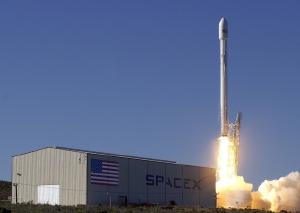Blog
Ion the Prize
9 March 2015
When you think of a rocket engine, you probably imagine one driven by a chemical reaction, that shoots a powerful flame capable of lifting a large spacecraft from the Earth’s surface. While such chemical rockets are necessary to overcome Earth’s strong gravity, they aren’t as useful in space. That’s because chemical rockets aren’t particularly efficient. So for probes like the Dawn spacecraft now in orbit around Ceres, we use another type of rocket engine known as an ion thruster.
 SpaceX
SpaceXFor any type of spacecraft, the key to a rocket engine is how much you can change the craft’s velocity (what’s often known as delta-v). Pound for pound, the more delta-v an engine can give a spacecraft, the more effective it is. That includes both the mass of the rocket and the mass of the fuel. A chemical engine produces thrust by a chemical reaction that superheats the propellent, which is then funneled out of the engine at high speed. Usually the propellent is the exhaust of the chemical reaction powering the rocket, so that the fuel itself becomes the propellent. It is basically a controlled explosion that can provide a great deal of thrust for a short period of time.
An ion engine takes a different approach. Rather than producing a large thrust in a short time, they produce a small thrust over a much longer time. The push given to a probe is about equal to the weight of a few coins in your hand, but it can provide that thrust for days or months at a time. In the lab, ion thrusters have operated continuously for 3 – 5 years without a failure. The only real limitation is the amount of available propellent, which is usually xenon gas.
Ion engines work by giving the gas an electric charge. This allows it to be accelerated to high speed across a potential voltage, after which it is thrust out of the engine. Since the engine is powered by electricity rather than a chemical reaction, it can derive its power by the solar panels of the probe. This, combined with their high efficiency allows ion engines to provide much greater delta-v than conventional engines. Over the course of the Dawn mission, it’s ion engines have provided a delta-v of more than 10 kilometers/second, which has allowed the probe to move into orbit around Vesta, leave that orbit, then reach Ceres and move into orbit around it. This could not have been achieved with chemical rocket engines.
There are plans to use ion engines for crewed missions, such as a journey to Mars, but for now it has allowed us to reach the largest body in the asteroid belt.